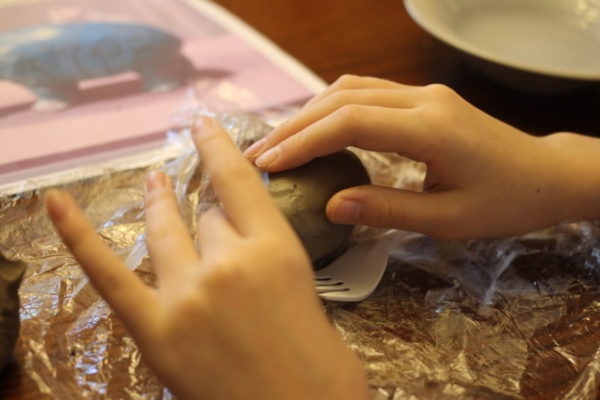Why Hands-on?
Why should you as homeschoolers take the time for hands-on, take the time for creativity, and take time for art? Read on!
Ansel Adams said this,
“In my mind’s eye, I visualize how a particular… sight and feeling will appear on a print. If it excites me, there is a good chance it will make a good photograph. It is an intuitive sense, an ability that comes from a lot of practice.” – Ansel Adams

How did Ansel Adams reach the point where he could look at vista and visualize the photograph? “It is an intuitive sense, an ability that comes from a lot of practice.” Lot’s of practice. That means hands-on learning that comes by doing, not just reading, taking notes, and testing.
Lately I’ve been writing a series of blog articles about adding hands-on to your school day. So far I’ve covered the benefits such as increased reading comprehension, increased independent learning, and, best of all, fun. Hands-on learning engages all of the brain. You see, hear, read, and do.
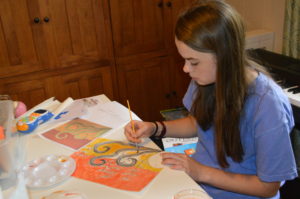
That means when you read about a cell and it’s structure, you begin the process of understanding how a cell works. Add in an illustration, and you begin to be able to better visualize in your mind how that cell looks as it works. Next, with modeling clay, or other materials, build a model of the cell.
Now, as you have carefully studied the illustration in order to build the model, you can further visualize each area of the cell in your memory. Watch a movie of how a cell divides. Now you’ve given yourself moving pictures to add to your experience.
Finally, label each area that you built. You just added language to the visualization, and have increased your understanding, vocabulary, and reading comprehension. And all in one science project! And to top it all off, you’ve add fun and interest to your day. It’s a win-win, and it works.
So today I want to make some suggestions about how to add hands-on learning that won’t have you ripping out your hair or causing you to stay up late searching the internet for ideas. Keep in mind that these are not comprehensive but are just a beginning.
Go on Field Trips for Hands-on
Seeing a dinosaur skeleton is so much better than looking at a drawing! Go to museums, go on trips, expose your children to art on museum walls. Give them the joy of hands-on history, science, and art. My kids use to say that all of our vacations included museums. They were right!
Museums are wonderful compilations of history, art, and science. And in some cases they are all under one roof! Take them, show them, and make sure that they get the full benefit by touching objects when it is permissible, reading the text of the descriptions to them, and pointing out the interesting facts and sites.
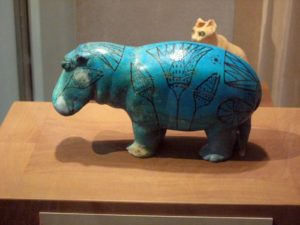
Have you ever seen a public school group go through a museum? It’s not unusual to see a class at a site, but there is often no one to really help them experience it. They may have a parent in the background counting heads, but there is often no one there to make sure that each student gets the full benefit. This is particularly true if they are on a class visit and get a boring docent who isn’t experienced with children.
Homeschoolers have a great advantage over classes when it comes to museum visits and field trips. You can act as their private guide to take them through the experience as you learn together. Heaven forbid you get a boring docent! But if you do, you can leave the group with your children and go on your own tour. You can even have the advantage of preparing your children for the visit by studying the time period and looking at the art or reading about the science ahead of time.
Give them time for Hands-on
Schedules are great and very necessary in the world of homeschooling. But scheduling every moment and working the schedule all the time, is just plain stressful. In other words, all work and no play, makes your homeschool stressful for all. Build unscheduled play time into your schedule.
Have plenty of craft materials and allow them to make a contained mess. Don’t always direct what they do. Allow your children to sit for hours and read, or experiment with materials. Allow them to engage in imaginative play. They are doing their own kind of work that builds their brains in ways that scheduled directed lessons can’t.
That doesn’t mean that you shouldn’t have scheduled lessons that are planned and led. It’s what our curriculum, Take Time for Art, is about. But there needs to be a balance where kids can go off and just be kids with their imaginations and their imaginative play.
Have A Place for a Contained Mess
For years our dining room table was a formica topped large table. And while I longed for a real wood fancy dining room table that I could dress up, that formica table was wonderful. We covered it with multitudes of craft materials including grout from making mosaics, paper mache, paint, glue, woodworking, bike parts, clay, sewing, knitting, plaster, and metal work. And because it wasn’t my fancy wood table, I didn’t care if the glue didn’t come up or the paint stayed, or the bike parts scratched.
Your place might be contained in a corner of your school room, on your kitchen table, or on an old desk that you found at a thrift shop. It doesn’t have to be fancy, it just has to be serviceable. And it’s nice if it is a space where things can sit and dry overnight without being disturb. Not a requirement, but it is one of those things that might make your life easier.
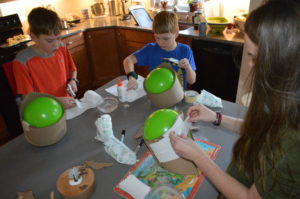
Have Basic Materials on Hand
Ever gotten to the hands-on part of your curriculum guide and realized that you couldn’t do the project because you were out of watercolors or needed permanent markers? Of course you have! We all have, and it’s frustrating! It’s why we include materials art packs with Take Time for Art. It’s also why I suggest you keep some basic art supplies at home for those quick impromptu ideas that your children may have. Here’s a beginning list to get you started.
- A good pair of scissors for each child that are age appropriate
- Decent but cheap paint brushes in different sizes including a round brush for watercolors
- Watercolors- don’t buy the cheapest brands due to quality concerns. Crayola and Artista are good choices.
- A few bottles of cheap acrylic craft paint including some metallic choices
- White glue- not school glue, white glue is stronger
- Permanent markers
- Tempera paint
- Poster board
- Cheap sketch paper 12 x 18
- #2 pencils
- A good pencil sharpener
- Modeling clay
- Air dry clay
- Table coverings
- Disposable water containers
- Sidewalk chalk
- Fabric scraps
- Crayons, markers, and colored pencils
- Construction paper
- glitter glue- much less messy than dry glitter!
Be Flexible and Allow Them to Soar
“My method is different. I do not rush into actual work. When I get a new idea, I start at once building it up in my imagination, and make improvements and operate the device in my mind. When I have gone so far as to embody everything in my invention, every possible improvement I can think of, and when I see no fault anywhere, I put into concrete form the final product of my brain.” – Nikola Tesla
There are many advantages to homeschooling, but one of my favorites is the freedom. For the most part, our kids knew that if they were working on something creative and interesting, I would give them the freedom and time to work. Yes, we made sure the basic subjects were covered. But if you wanted to disappear into the workshop and learn how to build an electric guitar, you had that freedom.
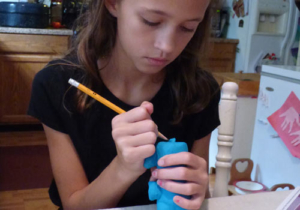
For some people this may be scary. After all, your curriculum says that you need to complete a certain amount of worksheets and tasks. There are tests to take and boxes to check off. My best advice that I wish someone had said to me early on is simply, “Relax.” You don’t get those days back when your kids are small, and it’s the perfect time to influence their faith and values. Promote peace, exercise faith, and celebrate the freedom in your homeschool. And do your absolute best to enjoy it!
So should you take time for hands-on, take time for the contained mess, give them time, and Take Time for Art? Absolutely!

